Table of Contents
A number of minerals are mined because of their use for other purposes than as ores of metals. Some of these minerals are of such importance as to warrant special mention.
Pyrite
Pyrite, or iron pyrites, FeS2, is found in workable deposits as follows:
- At or near contacts of quartz-porphyry, diorite, syenite, gabbro, and other igneous intrusions with crystalline limestone, quartzite, and other metamorphic rocks, as in eastern Ontario, near Madoc, Renfrew, etc.
- In vein-like bodies or lenses in Keewatin and other schists; for example, the Holdsworth deposit in the Goudreau area, Michipicoten district, Ontario.
- In the iron formation, as in the Michipicoten district, Ontario, where the majority of the pyrite deposits are found in the iron ranges; they are there associated with banded silica and siderite or limestone.
Since the pyrite weathers more easily than the rocks bounding it, it tends to form hollows between the rocks. Deposits of iron pyrites often contain enough copper to make them valuable as copper ores, and sometimes gold and silver add to the value of the ore; but the presence of other sulphides may decrease the value. Galena, zinc blende, stibnite, and mispickel are detrimental, if present in the ore.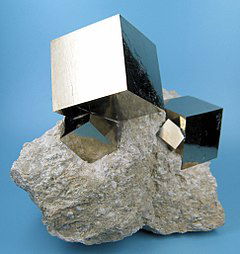
In prospecting for pyrite, it should be remembered that, by weathering, the mineral forms a rusty brown or sometimes reddish mass of gossan and since much of the material is washed away, this action often results in a hollow above the deposit. Reddish or rusty soil is an indication of pyrite. Sometimes there is a lack of vegetation, owing to the acid formed by the weathering of the pyrite. On digging down in places where these indications appear, the gossan will increase, and will become solid with increasing depth. Sulphate of iron of a whitish color and a decided taste may also appear. If the gossan is located on a steep hillside, the ore may be found uphill.
To be workable on its own account, a pyrite deposit must be practically free from gangue, so as to assay not less than 40% sulphur; it must be large enough to mine with no deadwork, and must be capable of producing a large tonnage. The low price of the mineral does not allow large cost for transportation to points where it is to be used. Competition of Louisiana and Texas sulphur has made it difficult to mine pyrite with profit; but since the tendency is upward in the price of sulphur, pyrite deposits may again become markable. A considerable amount of by-product pyrite made at low cost, mainly from copper ores, is already being sold.
Graphite
Graphite is found:
- in fissure veins in granite, gneiss, crystalline limestone, pegmatite and other intrusive rocks;
- in lenses and irregular masses, following the stratification of shale, slate, limestone, or gneiss;
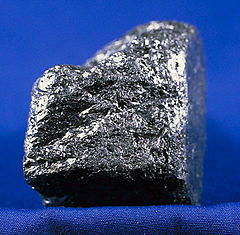
- in disseminations, in gneiss, crystalline limestone, mica schist, and similar rocks, generally near their contacts with intrusive igneous rocks, such as granite, diorite, or porphyry. Most of the deposits in Canada are of this kind.
Of the hundreds of graphite deposits known in Canada, very few have proved to be of economic value. The difficulty lies in separating the graphite from the other minerals, such as quartz and mica. For the finer grades, for use as a lubricant, in lead pencils, and for crucibles and electrotype making, everything of a gritty nature must be removed, and also all minerals that would tend to lower the fusion temperature of crucibles. This concentration is easy in the case of “flake” graphite disseminated in crystalline limestone. Fine-grained or “amorphous” graphite is not so easily purified.
Apatite
Apatite or “phosphate” is found in Eastern Ontario and Western Quebec in bunches, pockets, or large vein-like masses associated with mica, pink calcite, pyroxene and scapolite. These deposits are found in dikes of pyroxenite, particularly at their contacts with gneiss, mica schist, and crystalline limestone. Where the mica is plentiful and of good quality, the phosphate is apt to be scarce. On the other hand, the presence of a large quantity of apatite in the mica deposits is found to give a poor quality of mica.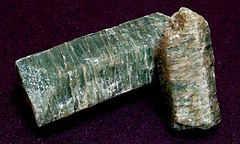
The discovery of very large sedimentary deposits of phosphate in the Southern States of the United States killed Canadian phosphate mining. The only chance of its revived lies in the possible, but not very probable, discovery of an unusually large and regular body of the mineral that could be mined more cheaply than the pocketty masses so far found. Some deposits in the Liévre River area, Quebec, are fairly large.
Sedimentary phosphate has been found near Banff, Alberta, but it is too lean to be merchantable. No. 1 phosphate carries at least 80% of phosphate of lime. The best found in Alberta does not go much above 30%. The phosphate used in the fertilizer plants at Trail and Kimberley, B.C., comes from sedimentary beds in Montana.
Fluorspar
Fluorspar, or fluorite, CaF2, is found in veins in limestone, shale, and sandstone, sometimes in the neighborhood of igneous intrusions ; but often, as in the Madoc area, Ontario, not obviously connected with intrusive rocks.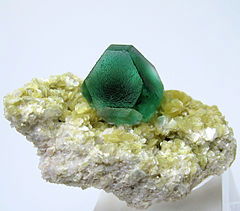
Large deposits are being worked on the south coast of Newfoundland. When well crystallized, the fluorspar is easily recognized; but when granular or sugary, it may escape notice. While often white, it may show green, blue, pink, yellow, or purple color. It is apt to be mixed with barite and celestite, only a small percentage of which is permissible When the fluorspar is to be used in the iron and steel industry. Quartz may be present in injurious quantity. “No. 1 ground” fluorspar is specified to contain not over 1% silica; No. 2 is allowed “less than 4% silica” but for refining steel, the requirements with regard to silica may be even stricter. Fluorspar to be used for enamels must be free from minerals like pyrite, which would give a color to the enamel.
Cryolite
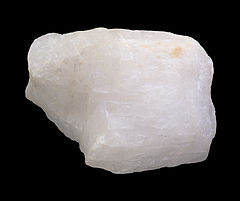 Cryolite, Na3AlF6, is found in pegmatite dikes. The only workable deposit known, in Greenland, is in a vein-like deposit in coarse-grained granite; it is probably to be classed as an unusual pegmatite. Near the cryolite is pegmatite, carrying tinstone. Pure cryolite is white, and it might easily be passed over as barren-looking quartz, if not carefully examined. But it is much softer than quartz, having the same hardness as calcite. Used principally in the manufacture of aluminum, forming a molten bath in which the purified bauxite is dissolved. Considerable quantities are used in the manufacture of enamels. As the pre-Cambrian of Canada has very numerous pegmatite dikes, granite areas where these dikes are seen, should be prospected for cryolite. The Greenland supply is not inexhaustible. The discovery of a second deposit within the limits of eastern Canada would he very important for the manufacturing of aluminum. Cryolite is now being made artificially out of fluorite, which it resembles chemically,
Cryolite, Na3AlF6, is found in pegmatite dikes. The only workable deposit known, in Greenland, is in a vein-like deposit in coarse-grained granite; it is probably to be classed as an unusual pegmatite. Near the cryolite is pegmatite, carrying tinstone. Pure cryolite is white, and it might easily be passed over as barren-looking quartz, if not carefully examined. But it is much softer than quartz, having the same hardness as calcite. Used principally in the manufacture of aluminum, forming a molten bath in which the purified bauxite is dissolved. Considerable quantities are used in the manufacture of enamels. As the pre-Cambrian of Canada has very numerous pegmatite dikes, granite areas where these dikes are seen, should be prospected for cryolite. The Greenland supply is not inexhaustible. The discovery of a second deposit within the limits of eastern Canada would he very important for the manufacturing of aluminum. Cryolite is now being made artificially out of fluorite, which it resembles chemically,
Barite
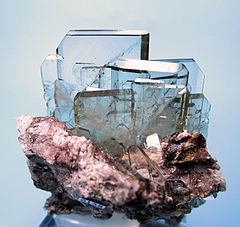 Barite, BaSO4, is found in veins in a great variety of rocks, but most frequently in limestone and dolomite; also, ín slate, gneiss, syenite, díabase, hornblende schist, and other igneous and metamorphic rocks. It is a fairly common vein matter in regions where veins of metallic ores are found; but to be useful as a white paint, it should be free from mineral that would give a color to the ground product. Its weight and softness should call attention to it in the field. When crystals are noticed, the “crested” appearance in characteristic (See Art. 116). In Ontario and southwestern Quebec, barite veins are found in a number of places, generally mixed with galena, fluorspar, and calcite. In the Matachewan area of northern Ontario, a number of important barite veins occur, some of which cut the sedimentary rocks of the Cobalt series. Similar barite veins are found in the Thunder Bay silver area. In Nova Scotia, barite has been mined near Lake Ainslie, where the veins occur in preCambrian felsite. At North Cheticamp, the barite veins are found in schistose rock, probably of preCambrian age. Near Five Islands, the barite is in a brecciated zone in slate, etc. Large deposits near Windsor, Nova Scotia, are now being worked, largely to supply the “heavy mud” used in drilling for oil wells.
Barite, BaSO4, is found in veins in a great variety of rocks, but most frequently in limestone and dolomite; also, ín slate, gneiss, syenite, díabase, hornblende schist, and other igneous and metamorphic rocks. It is a fairly common vein matter in regions where veins of metallic ores are found; but to be useful as a white paint, it should be free from mineral that would give a color to the ground product. Its weight and softness should call attention to it in the field. When crystals are noticed, the “crested” appearance in characteristic (See Art. 116). In Ontario and southwestern Quebec, barite veins are found in a number of places, generally mixed with galena, fluorspar, and calcite. In the Matachewan area of northern Ontario, a number of important barite veins occur, some of which cut the sedimentary rocks of the Cobalt series. Similar barite veins are found in the Thunder Bay silver area. In Nova Scotia, barite has been mined near Lake Ainslie, where the veins occur in preCambrian felsite. At North Cheticamp, the barite veins are found in schistose rock, probably of preCambrian age. Near Five Islands, the barite is in a brecciated zone in slate, etc. Large deposits near Windsor, Nova Scotia, are now being worked, largely to supply the “heavy mud” used in drilling for oil wells.
Celestite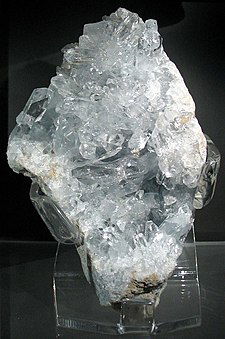
Celestite, SrSO4, is commonly called “strontium” by the miner, which name is also applied to the much rarer mineral, strontianite. SrCO3. Celestite is found in veins, commonly in crystalline limestone, but also in sandstone and shale. It resembles barite in appearance, weight, and softness, but is sometimes of a pale blue color and of a somewhat fibrous structure. It has been used in place of barite in the manufacture of the paint, lithopone; it has been largely used in the manufacture of sugar and fireworks. Like barite, it is often found in veins with galena, fluorspar and calcite. It is plentiful in some of the fluorspar veins of the Madoc area, Ontario. In Renfrew county, Ontario, near Calabogie, celestite has been mined from a vein in crystalline limestone. A similar but smaller vein occurs near Arnprior, Ontario.
Asbestos
Serpentine asbestos is the most valuable of the fibrous minerals to which the name asbestos is applied. As produced in the province of Quebec it has a soft silky fiber, which makes it easy to spin and weave. It is found in veins in serpentine rock.
Asbestos was first discovered in Quebec by being turned up by a plow, the fibres having stood the weathering longer than the serpentine rock. In prospecting serpentine areas, parts of which are covered, some attempt should be made to find asbestos fibres in the overburden, where not too deep. Small quantities of asbestos are sometimes seen in serpentine formed in the contact zone of limestone with an igneous intrusion. In such a situation, the quantity is not likely to be of commercial importance. When discovered, its quality can be roughly tested by spinning it with the fingers. On account of the high price of asbestos, a small percentage in the rock may pay under favorable conditions. At Thetford, Quebec, where the fibre is unusually fine and pliable, rock averaging only 3% or 4% of asbestos is profitably mined. With a rather poorer quality of fibre, rock containing 5% or 6% is payable. The asbestos mines of Quebec are in the vicinity of Thetford, Black Lake, East Broughton, and Danville, in the southeastern part of the province, where the serpentine belt is composed of peridotite, pyroxenite, gabbro, etc. The veins of asbestos are flanked on both sides by serpentine of the same composition, both having been formed by the alteration of peridotite. In Ontario, in the Porcupine area, and also near Lake Abitibi, are similar intrusive rocks, the peridotite of which has been largely altered to serpentine. Some asbestos of fine quality has been taken out of a prospect in Deloro township in the Porcupine area. To the eastward in Munro township an asbestos mine of moderate size has been working for some years, In the Cassiar district of northern British Columbia mining of asbestos was established recently on deposits that appear capable of production of major quantities of the mineral.
Magnesite
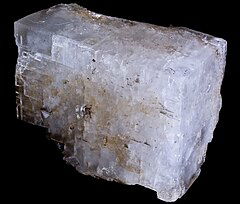 Magnesite, MgCO3 is found in serpentine rock as a hard, non-crystalline mineral, with a fracture like broken porcelain; it is also found in talc schist and other magnesian rocks. The crystalline variety is found in crystalline limestone and dolomite that have been changed by intrusions of gabbro and other basic and intermediate rocks. The magnesite deposits in Grenville and Harrington townships, Quebec, are crumpled, banded and fractured. The rock varies from dolomite, which is carbonate of lime and carbonate of magnesia—roughly 50-50—to fairly pure carbonate of magnesia, or magnesite; but the general appearance is much the same in all these varieties. As dolomite dissolves in rain water more easily than magnesite, the surface of the mixed rock is pitted. Dolomite areas that are partly magnesite show serpentine, talc, pyroxene, mica, etc.
Magnesite, MgCO3 is found in serpentine rock as a hard, non-crystalline mineral, with a fracture like broken porcelain; it is also found in talc schist and other magnesian rocks. The crystalline variety is found in crystalline limestone and dolomite that have been changed by intrusions of gabbro and other basic and intermediate rocks. The magnesite deposits in Grenville and Harrington townships, Quebec, are crumpled, banded and fractured. The rock varies from dolomite, which is carbonate of lime and carbonate of magnesia—roughly 50-50—to fairly pure carbonate of magnesia, or magnesite; but the general appearance is much the same in all these varieties. As dolomite dissolves in rain water more easily than magnesite, the surface of the mixed rock is pitted. Dolomite areas that are partly magnesite show serpentine, talc, pyroxene, mica, etc.
The principal uses of magnesite are for linings and hearths of steel furnaces, or magnesia bricks, and for the manufacture of the metal, magnesium. For the manufacture of magnesia bricks, magnesite should be low in lime, not carrying more than 2%. Although the Quebec magnesite carries about 8% or 9% lime, it is stated that, in spite of the high lime content, good magnesia bricks can be made from it, A certain percentage of iron helps the sintering in making the bricks. The European magnesite has this naturally; and where it is wanting, it is easy to supply the lack by adding blast furnace slag.
Hydromagnesite is a hydrated carbonate of magnesia. It has been found in Atlin, B.C., in the bottom of dried-up lakes, as a powdery deposit; it can be used for the same purposes as magnesite.
Talc
The best talc deposits have been found in crystalline limestone of the dolomite kind, in the neighborhood of igneous intrusions. It is also found in association with serpentine, talc schist, chlorite schist, peridotite, and other magnesium rocks. It is easily “spotted” by its softness and soapy feeling. Talc is a cheap mineral not worth attention unless it is near transportation. But a good deposit of either pure talc or soapstone that is near a railway or water transportation, may be of value.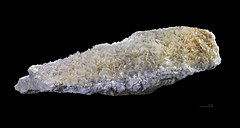
For its principal uses,—as a filler and surface coating for paper (fibrous talc preferred), filler for white cotton, toilet powders, soaps, and enamel paints,—the talc must be free from harder minerals, such as calcite and pyroxene, which would give the finely ground product a gritty character. For most of these purposes, it must also be free from color when ground. Lower grades of ground talc are used as foundry facing, in rubber manufacture, in magnesite flooring, and to prevent sticking of roofing paper. The best quality of white talc has been produced for a number of years from deposits near Madoc, Ontario, where the mineral is found in crystalline limestone, largely dolomite in composition. The talc owes its origin probably to an intrusion of granite nearby.
Soapstone is fine-grained, impure talc, which is quarried and used for laboratory table tops, electric switchboards, sinks, wash tubs, hot plates, stove linings, acid tanks, and other apparatus where its qualities of easy shaping, resistance to heat and acids, and non-conductivity for heat and electricity make it valuable. Good deposits have been discovered near Dryden and Mine Centre, Ontario and in Megantic County, Quebec. There is a growing demand for soapstone for the lining of furnaces used to recover the alkali in the sulphate pulp process.
Feldspar
The useful feldspars are chiefly orthoclase and microcline, which have the same composition:

Soda (Na2O) may take the place of part of the potash, and sometimes a little lime (CaO) does the same. Albite is sometimes used; it is soda feldspar of the following composition:

Potash and lime usually take the place of part of the soda. For industrial purposes, feldspar must be free from minerals like tourmaline, garnet, hornblende, and black mica, which give a gray color to the glaze or enamel, for making which, feldspar is largely used; also it must not have much quartz mixed with it, some users specifying “not more than 2%;” and it must likewise be free from hematite and other iron minerals. These minerals rule out the great bodies of granite and syenite that might, otherwise, be available.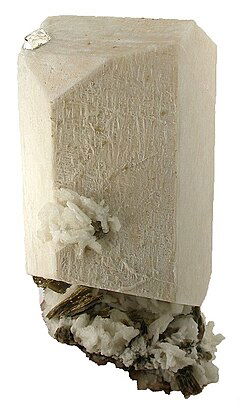
Commercial feldspar is obtained from pegmatite granite and syenite dikes, where the coarse crystallization has caused the separation of the feldspar in large masses of the pure mineral. In some of these dikes the quartz and feldspar are crystallized together as graphic granite; and if the quartz is not too plentiful (as much as 25% is allowable), the material is merchantable, if of good quality otherwise. Potash feldspar has the lowest temperature of fusion, a desirable property for its use in pottery manufacture; the fusion is still lower if a small percentage of soda is present. Albite is sometimes mixed with a pure potash feldspar, to lower the melting point. Lime in feldspar causes a higher melting point, and it also causes the articles to shrink a little on firing.
The main uses of feldspar are in the manufacture of china-clay products. (The clay industries are often alluded to as the ceramic arts.) Ground feldspar is mixed with the clay, as a binder, and it is also used as a glaze for the surface, for which purposes a low fusion temperature is desirable. Feldspar is used in enameling bricks and metal ware, as a binder in the manufacture of emery wheels and other abrasive wheels, etc., for opal glass, in scouring soaps and polishes, as surfacer for some roofing materials, and in the surface layer of artificial stone to give it an attractive appearance. For most of these purposes, low-grade feldspar may be used. The finest grade of pure potash feldspar is used in the manufacture of artificial teeth. This dental spar brings a high price.
Pegmatite dikes are very common in regions where intrusive granite and syenite are plentiful. But very few of these dikes fulfil the requirements for a good feldspar quarry; namely, nearness to transportation, freedom from certain minerals mentioned above, large tonnage, and low cost of quarrying. Feldspar of commercial quality has been mined at a number of places in southeastern Ontario and southwestern Quebec, but among the hundreds of pegmatite dikes that have been examined, very few fulfil the requirements.
In recent years nepheline syenite from large deposits in Peterborough county, Ontario, have provided a material much like feldspar in its useful qualities. It has gained an important share of the market.
Lithium Minerals
 There are a number of lithium minerals of economic value found in pegmatite dikes, and sometimes in granite and gneiss. Lepidolite is used largely in making special kinds gonite are the principal ones, Lepidolite usually occurs in masses of small scales of a pinkish or light purple color, but in Wakefield township, Quebec, the mineral is in large “books” or crystals of a gray bronze color, It was first mined there as ordinary mica, but its brittleness called attention to it, and analysis revealed the lithium in it.
There are a number of lithium minerals of economic value found in pegmatite dikes, and sometimes in granite and gneiss. Lepidolite is used largely in making special kinds gonite are the principal ones, Lepidolite usually occurs in masses of small scales of a pinkish or light purple color, but in Wakefield township, Quebec, the mineral is in large “books” or crystals of a gray bronze color, It was first mined there as ordinary mica, but its brittleness called attention to it, and analysis revealed the lithium in it.
Lepidolite is largely used in making special kinds of glass. It lowers the expansion and contraction by changes of temperature, makes a harder surface, and a less brittle body, and gives greater brilliance to the glass. These qualities make lithium glass useful for electric light bulbs, X-ray tubes, and wherever great strength is desirable. Amblygonite and spodumene are used partly in the manufacture of lithium chemicals for medicines, photography, red flares, and storage batteries; but in recent years they have been used mainly in connection with the nuclear development which has created a large market for lithium minerals. Lepidolite is rather easily spotted by its peculiar color and mica structure, but spodumene and amblygonite may easily be overlooked, as they are mostly white minerals that might be mistaken for feldspar or quartz, The three lithium minerals often occur together, and where lepidolite is noticed, the other two should be looked for. Amblygonite, lepidolite, and spodumene have been found in commercial quantities in north- western Quebec, and there are large deposits in southeastern Manitoba.
Mica
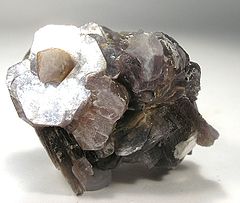 Muscovite or white mica, and phlogopite, or amber mica, are the principal commercial micas. White mica is to be looked for in pegmatite granite dikes. To be merchantable it must be in large crystals or “books,” the larger the better, other things being equal. It must split into very thin sheets, which will bend without breaking, and snap back when bent and released. The sheets must be free from checks and crinkles. Spots of hematite and other dark minerals lower the value, as does any stain or strong coloring. Muscovite is sometimes distinctly colored, that mined in India being usually wine-colored or purplish. In Ontario, white mica has been produced in the Parry Sound district, and west of Mattawa. In Quebec, it has been found near the mouth of the Saguenay River, on the Peribonka River, near Murray Bay, and at other places. In British Columbia, it occurs near Tete Jaune Cache, and also near Finlay River.
Muscovite or white mica, and phlogopite, or amber mica, are the principal commercial micas. White mica is to be looked for in pegmatite granite dikes. To be merchantable it must be in large crystals or “books,” the larger the better, other things being equal. It must split into very thin sheets, which will bend without breaking, and snap back when bent and released. The sheets must be free from checks and crinkles. Spots of hematite and other dark minerals lower the value, as does any stain or strong coloring. Muscovite is sometimes distinctly colored, that mined in India being usually wine-colored or purplish. In Ontario, white mica has been produced in the Parry Sound district, and west of Mattawa. In Quebec, it has been found near the mouth of the Saguenay River, on the Peribonka River, near Murray Bay, and at other places. In British Columbia, it occurs near Tete Jaune Cache, and also near Finlay River.
Amber mica is found in pockets with pink calcite, pyroxene (diopside), scapolite, and sometimes apatite in dikes of “pyroxenite” (a rock composed of pyroxene with more or less feldspar), mostly at or near the contacts of these dikes with crystalline limestone, gneiss, or mica schist. Three kinds of amber-mica deposits are here described:
- Fissure deposits, with calcite (generally pink) as the gangue ; the walls are well-defined and often lined with crystals of pyroxene. The mica crystals are usually found most abundantly near one or both of the walls; and when the calcite is white, the crystals of mica are apt to be larger.
- Contact deposits, found along the contacts of the pyroxenite dikes with the gneiss, etc. Calcite is the vein matter.
- Pockets, or irregular bodies of mica with calcite, in the pyroxenite dikes. Pyroxene crystals are common, and also apatite crystals. Since calcite weathers away faster than mica, apatite, and pyroxene, these minerals are often found lying in the covering over mica deposits; but if the deposit is on a hillside, the loose material may have been moved down hill a considerable distance. There are often a number of such pockets connected by stringers of calcite. For these irregular deposits, surface prospecting by trenching and stripping is the best way. In Ontario, amber mica is found plentifully in Frontenac, Leeds, and Lanark counties. In Quebec, it has been mined in a large area north of Ottawa.
Corundum
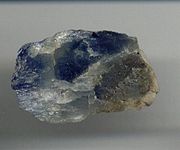 Corundum, Al2O3, is found in nepheline-syenite, peridotite, pyroxene, and amphibole, and sometimes in gneiss and chlorite schist. It is easily spotted by its six-sided crystals, which are harder than quartz. The common colors are gray, white, and brownish. While the crystals have no true cleavage, they usually show a clean break (parting) at intervals across the length of the crystal.
Corundum, Al2O3, is found in nepheline-syenite, peridotite, pyroxene, and amphibole, and sometimes in gneiss and chlorite schist. It is easily spotted by its six-sided crystals, which are harder than quartz. The common colors are gray, white, and brownish. While the crystals have no true cleavage, they usually show a clean break (parting) at intervals across the length of the crystal.
Corundum has been found plentifully in Eastern Ontario, usually in nepheline-syenite, and at one time considerable quantities were mined for the manufacture of corundum wheels and other grinding instruments. Being close to diamond in hardness, corundum is a first rate abrasive, that is, a material suitable for grinding and polishing. The severe competition of carborundum (SiC) and alundum (artificial corundum) has made it hard to mine corundum with profit.
Garnet
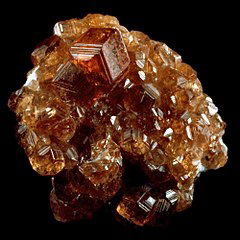 The common red garnet, almandine, silicate of iron and aluminum, is the one commonly used as an abrasive. It is found in gneiss, mica schist, and crystalline limestone,—sometimes in granite and other igneous rocks,—but in commercial quantity and quality, it should be looked for in gneiss and mica schist. The common variety is easily recognized by its red color, hardness, and the rounded shape of the crystals. Only a small proportion of the deposits are of satisfactory quality. Shell garnet, that is, garnet in crystals scattered through the rock, is the best; pocket garnet, that is, the mineral occurring in round bunches, comes next; massive garnet, or garnet in fine-grained masses, is not so good, being usually mixed with other minerals. The garnet crystals are often coated on the outside with mica and other soft minerals, so that their true color is not seen, but the rounded shape is noticeable. It is found plentifully in a region extending eastward from Georgian Bay through eastern Ontario and western Quebec, but the quality and other conditions required are rather exacting, so that very few deposits can be worked profitably. Garnet has been produced near Bancroft, Ontario, and in Ashby township, where it is found in a band of quartzite.
The common red garnet, almandine, silicate of iron and aluminum, is the one commonly used as an abrasive. It is found in gneiss, mica schist, and crystalline limestone,—sometimes in granite and other igneous rocks,—but in commercial quantity and quality, it should be looked for in gneiss and mica schist. The common variety is easily recognized by its red color, hardness, and the rounded shape of the crystals. Only a small proportion of the deposits are of satisfactory quality. Shell garnet, that is, garnet in crystals scattered through the rock, is the best; pocket garnet, that is, the mineral occurring in round bunches, comes next; massive garnet, or garnet in fine-grained masses, is not so good, being usually mixed with other minerals. The garnet crystals are often coated on the outside with mica and other soft minerals, so that their true color is not seen, but the rounded shape is noticeable. It is found plentifully in a region extending eastward from Georgian Bay through eastern Ontario and western Quebec, but the quality and other conditions required are rather exacting, so that very few deposits can be worked profitably. Garnet has been produced near Bancroft, Ontario, and in Ashby township, where it is found in a band of quartzite.
Garnet is used mostly for making garnet sand paper. It is harder than quartz, and the grains easily break and keep a fresh cutting edge, whereas quartz grains wear smooth. Garnet sand paper is in demand for polishing leather, wood, and brass. Garnet concentrates were selling at $80 a ton in 1955.
Tripolite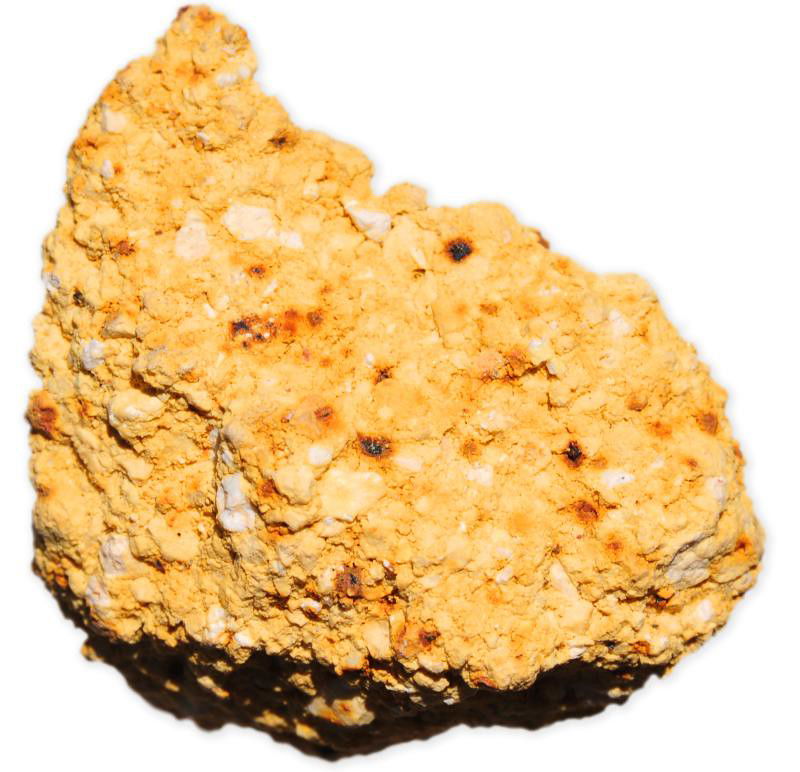
Other names for tripolite are infusorial earth, diatomaceous earth or diatomite, and fossil flour. It is impure silica made up of the very small shells or cases of minute plants that live at the surface of the water or on larger plants, in seas and lakes. The bottoms of lakes may become covered to a considerable depth with a fine sediment of this material. Although like flour in appearance, the grains are hard enough to scratch glass; consequently, tripolite is used as a polish, particularly for metals. It is also used as a covering for steam pipes, for water filters, and a number of other purposes. The market price of the ground material is $30 to $35 a ton. It is found plentifully in the Maritime Provinces. Large deposits have been found in British Columbia, one near Quesnel being many square miles in extent and about 40 feet thick.
Rottenstone
This is a porous rock, composed mostly of very fine-grained siliceous material (quartz) and oxide of iron, left by the weathering of siliceous limestone or limey mica-schist; its reddish or rusty color is noticeable. It is used in finishing the varnished surfaces of furniture, pianos, etc., and in polishing celluloid and plate glass. Tripoli is a similar material formed by the alternation of chert or other siliceous rock.
Fuller’s Earth
This is a clay-like material, gray, dark green, or brownish in color; a silicate of alumina, etc., differing from clay in having little or no plasticity, that is, the property of making with water a sticky mass that can be shaped, as is done in the manufacture of pottery. Fuller’s earth is formed as a sedimentary deposit in the younger geological formations, and also, sometimes, as a product of the weathering of basic dikes. It is used for purifying fats and oils, and in the refining of Petroleum. An extensive bed of volcanic dust near Waldeck, Saskatchewan, has been successfully used instead of fuller’s earth. Bentonite is a substance much like clay, but having an extraordinary power of absorbing large quantities of water. It has been found at several points in British Columbia, Alberta, and Saskatchewan. It has a number of uses, including filters for decolorizing petroleum products, as facial and “beauty” clay, etc. It has been tried successfully to increase the retention of clay in paper making.
Clay
The properties that make clay valuable are its plasticity, and the formation of a hard, durable material when it is dried and burned. It is a secondary mineral, formed by the weathering of rocks, particularly those rich in feldspar. The most plastic clay is that which has been worked on by water for a long time; and this condition is fulfilled by clay that has been carried by running water and deposited in still water. Brick clay is plentiful in Canada; but, in limestone districts, it must be carefully selected, as many beds are useless on account of the presence of nodules of limestone. When the clay is burned, these nodules form quicklime, which slowly slakes, at the same time swelling and bursting the brick or tile. China clay, is the most valuable variety; it may be found as a residual deposit above granite or other rocks that are rich in feldspar, or as a sedimentary deposit in places that have once been the bottoms of lakes or other bodies of still water. Fireclay is a variety that stands a very high temperature without melting. It is sometimes found in coal deposits, but is by no means confined to the coal beds. China clay has been mined near Huberdeau, Quebec. where it is found in a crush zone of quartzite. There are deposits of china clay and fireclay on the Mattagami and Missinaibi rivers in Ontario, near where these rivers cross the contact between the pre-Cambrian and the Paleozoic rocks. It is quite possible that these clay deposits may be found between these rivers, and east and west of them.
Deposits from Evaporation
The present existence of salt lakes, such as that in Utah, makes it fairly certain that in past geological ages, similar bodies of water have dried up and left, as sedimentary deposits, substances that the water had in solution. In this way beds of gypsum, salt, and potash salts are accounted for, and possibly, also, Chile nitrate. All of these substances, except gypsum, have a decided taste; and the prospector who has formed the habit of tasting minerals is not likely to pass these by unnoticed.
In the regions of Western Canada where the rainfall is scanty, there are lakes and old lake bottoms in which deposits of Epsom salts (MgSO4. 7H2O), mirabilite (Na2SO4. 10H2O), and hydromagnesite have been found. Of these the first two have a decided taste. Borax and similar minerals may be found in such localities.
Gypsum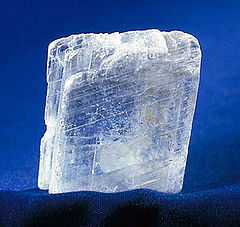
Gypsum (CaSO4. 2H2O) is found as a deposit in sedimentary rocks of many ages, With shale, sandstone, and limestone; it is often found with rock salt. The almost valueless mineral, anhydrite (CaSO4) is found with gypsum, and may be mistaken for it; but it is harder, heavier, and breaks into square pieces. Gypsum is easily recognized by its softness, its whiteness (sometimes gray or reddish from impurities), and the very perfect cleavage of its crystals, when they are large enough to observe. While a cheap mineral, it is easily mined, and is apt to be in large quantities. It should not be forgotten that gypsum and anhydrite may be accompanied by rock salt and the much more valuable potash salts. There are extensive beds of gypsum in Nova Scotia and New Brunswick, and there has been large production in both provinces, especially in Cape Breton, near Minas Basin and Chignecto Bay, and near Moncton. Large deposits of gypsum are known to occur in the little explored Paleozoic rocks bordering James’s Bay and Hudson Bay. Gypsum has been produced for many years in Ontario from beds that extend from Paris 30 or 40 miles eastward.
Salt
The solid material found in the earth’s crust as rock salt has been doubtless deposited by the evaporation of salt lakes or other bodies of water that had no free outlet into the ocean. Rock salt may be found in sedimentary rocks of many ages; its presence is sometimes shown by salt springs, the water of which in its underground course has dissolved the salt. There are salt beds in Southern Ontario in an area extending from Kincardine on Lake Huron to the shore of Lake Erie southward. The beds are at a depth of about 1000 feet. The salt is obtained as brine by pumping. Salt springs are not uncommon in New Brunswick and Nova Scotia, and in several places beds of rock salt are being mined through bore holes and through shafts. At Malagash, Nova Scotia, the beds are less than 100 feet from the surface.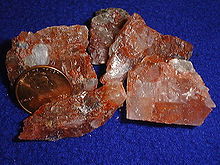
Potash Salts
Potash salts are found in the same situations as rock salt, with which they are associated in the known deposits in Germany and France. Their great value for agricultural fertilizers would justify a careful search for deposits in Canada. Considerable quantities have been found in the salt beds of Malagash, Nova Scotia, and in Saskatchewan where extensive beds are being developed by shafts.
Nitrate
Sodium nitrate (NaNO3) is found in large quantity in a desert region in Chile, where it is associated with rock salt, gypsum, mirabilite, etc. This deposit is the principal source of nitrate for the world’s supply. It is used very largely in agriculture, and also in numerous chemical manufactures. It is possible that the counterpart of this rare South American deposit may be found in some rainless arid region of North America.
Coal, Petroleum, Natural Gas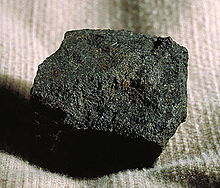
The search for these very important materials by modern methods is a specialty requiring thorough knowledge of geology and an extensive field experience. Coal has never been found in important quantities in rocks older than the Devonian age, and not very much has been found in rocks of that age. This fact restricts the favorable prospecting field in Canada pretty much to parts of the maritime provinces, of Alberta, and of British Columbia.
During recent years important oil and gas fields have been found in Alberta and Saskatchewan. These are expected to furnish, in due course, sufficient oil to supply the Canadian demand, as well as gas for the industrial areas of Ontario and Quebec.
Oil and natural gas have been found in important quantities in sedimentary rocks of all ages from the Cambrian to the youngest, usually associated with salt water.
